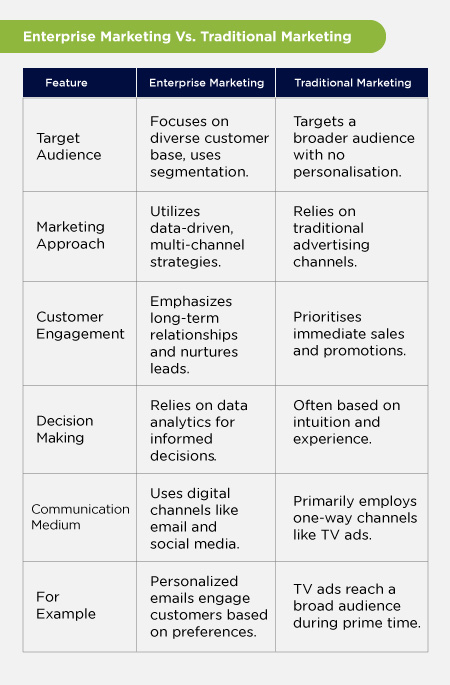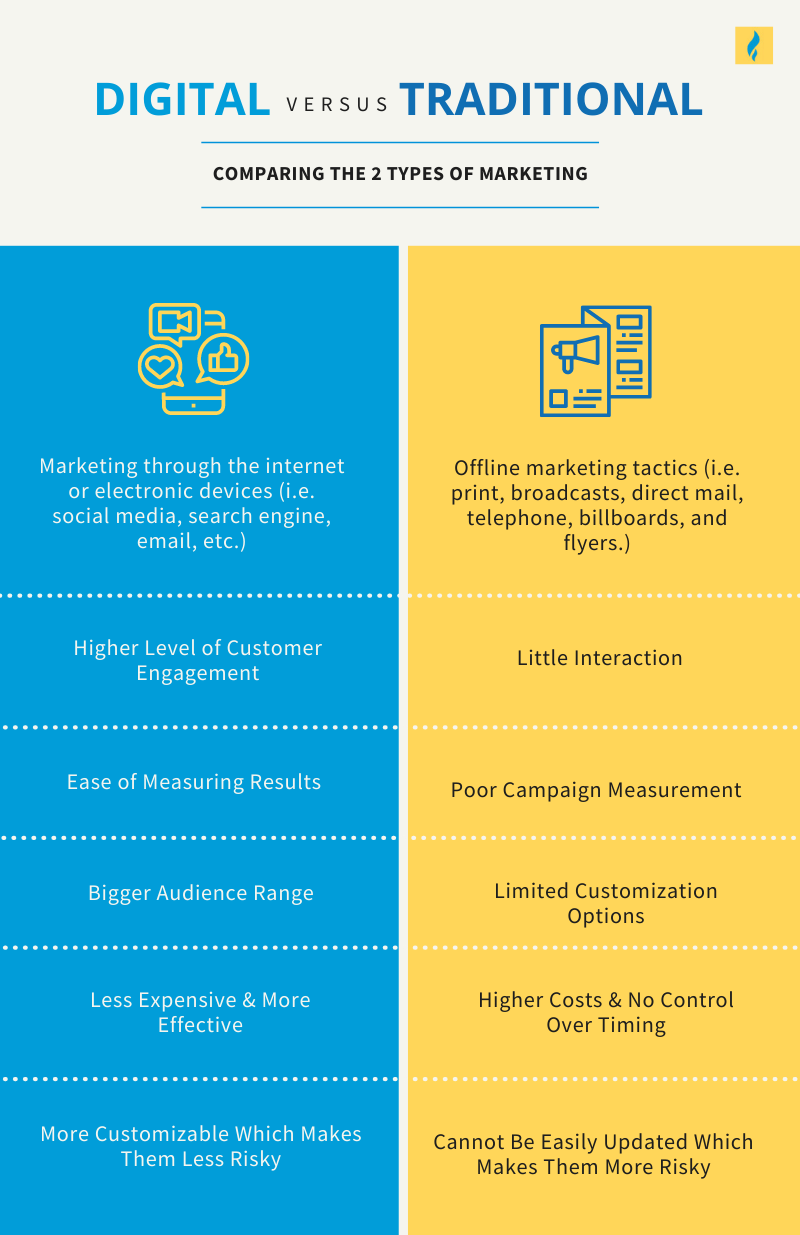Email marketing and traditional marketing are both powerful tools. Each has its own strengths and weaknesses.
In today’s digital world, businesses often face a tough choice between email marketing and traditional marketing. Email marketing offers speed, cost-effectiveness, and precise targeting. Traditional marketing, on the other hand, has a long history of reaching large audiences through print, TV, and radio.
Understanding the differences and benefits of each can help you decide which strategy suits your business best. In this blog post, we will explore the key aspects of email marketing and traditional marketing, and how they can impact your marketing efforts. Let’s dive in and see which approach might work best for you.

Table of Contents
Introduction To Marketing Strategies
Choosing the right marketing strategy is crucial for any business. Two popular approaches are Email Marketing and Traditional Marketing. Each has unique benefits and challenges. Let’s explore these strategies and see how they compare.
Importance Of Roi
Return on Investment (ROI) is key to evaluating marketing strategies. Businesses want to ensure their marketing dollars are well spent.
Email Marketing often shows a high ROI. It is cost-effective and targeted. Marketers can track metrics and adjust campaigns quickly.
In contrast, Traditional Marketing methods like print ads or TV commercials can be costly. They reach a broad audience but lack precise targeting. Measuring ROI can be difficult, making it hard to justify expenses.
Defining Email Marketing
Email Marketing involves sending promotional messages to a list of subscribers. It uses email to build relationships and drive sales.
- Personalization: Emails can be tailored to individual preferences.
- Automation: Campaigns can run automatically based on user actions.
- Analytics: Marketers can track open rates, click rates, and conversions.
These features make email marketing efficient and measurable. Businesses can see direct results from their efforts.
Defining Traditional Marketing
Traditional Marketing includes methods like print ads, TV commercials, and billboards. These methods aim to reach a broad audience.
- Reach: Traditional media can reach large numbers of people.
- Brand Awareness: These ads create a strong visual presence.
- Credibility: Established media platforms can lend credibility to the message.
Despite these strengths, traditional marketing can be expensive. It lacks the personalization and direct tracking of email marketing. This makes it harder to measure and optimize.
Cost-effectiveness
One of the most crucial aspects of any marketing strategy is cost-effectiveness. Both email marketing and traditional marketing have their own costs and benefits. Understanding these can help businesses allocate their budgets more efficiently. Let’s delve into the cost-effectiveness of each method.
Budget Considerations
Email marketing is known for its low cost. You don’t need to spend much on materials or distribution. A basic email campaign can be set up with minimal expenditure. On the other hand, traditional marketing involves higher costs. You need to account for printing, postage, and distribution.
To illustrate the cost differences, consider the following table:
| Marketing Method | Costs |
|---|---|
| Email Marketing | Low (Email software, Design) |
| Traditional Marketing | High (Printing, Postage, Distribution) |
As seen, email marketing is more budget-friendly. This makes it an attractive option for small businesses and startups.
Resource Allocation
Allocating resources efficiently can significantly impact the success of your marketing efforts. Email marketing requires fewer resources. You can manage campaigns with a small team. Often, a single person can handle various tasks.
Traditional marketing demands more resources. You might need a larger team to handle printing, distribution, and managing physical materials. This can lead to higher labor costs and increased complexity.
Consider the following points for resource allocation:
- Time: Email campaigns can be set up quickly. Traditional campaigns take more time.
- Personnel: Email marketing needs fewer people. Traditional methods may need more staff.
- Materials: Email marketing is digital. Traditional marketing uses physical materials.
In summary, email marketing offers a more cost-effective and resource-efficient solution. Traditional marketing, while effective, incurs higher costs and resource demands.
Target Audience Reach
Understanding the target audience reach is crucial in marketing. It determines how effectively a message reaches potential customers. Email marketing and traditional marketing each have unique ways to reach their audience. Let’s explore these methods in detail.
Email List Segmentation
Email marketing allows for precise targeting through list segmentation. This means dividing your email list into smaller groups based on specific criteria. These criteria can include:
- Demographics
- Purchase history
- Engagement levels
Segmentation helps in sending personalized messages to each group. Personalized messages can result in higher open rates and better engagement. Businesses can address the specific needs of each segment. This tailored approach ensures more relevant communication.
| Criteria | Example |
|---|---|
| Demographics | Age, Gender, Location |
| Purchase History | Previous purchases, Frequency |
| Engagement Levels | Opened emails, Clicked links |
Mass Media Reach
Traditional marketing often relies on mass media to reach its audience. This includes:
- Television ads
- Radio spots
- Print media
Mass media can reach a large number of people quickly. It is useful for brand awareness and broad messaging. Yet, it lacks the precision of email segmentation. Messages are general and may not resonate with everyone. It can also be more costly and harder to measure effectiveness.
| Medium | Reach |
|---|---|
| Television | Millions |
| Radio | Thousands to Millions |
| Print Media | Thousands |
Both email marketing and traditional marketing have their pros and cons. The choice depends on the business goals and audience.

Engagement Levels
Engagement levels are crucial in determining the effectiveness of any marketing strategy. Email marketing and traditional marketing have unique ways of engaging with audiences. It’s important to understand how each method performs in terms of open and click rates, and customer interaction.
Open And Click Rates
Email marketing boasts high open and click rates. This is due to the personalized nature of emails. Marketers can target specific audiences with tailored content. They can also track how many people open the email and click on links.
In contrast, traditional marketing relies on broader methods. Examples include billboards, flyers, and TV ads. It’s harder to measure engagement directly. You can’t know exactly how many people saw your ad or took action.
| Marketing Type | Open Rate | Click Rate |
|---|---|---|
| Email Marketing | 20-30% | 3-5% |
| Traditional Marketing | Unknown | Unknown |
Customer Interaction
Email marketing allows for direct customer interaction. Customers can reply to emails, ask questions, or provide feedback. This two-way communication builds relationships and trust.
With traditional marketing, interaction is less direct. Customers can’t respond to a billboard or TV ad. They might call a number or visit a store, but it’s not immediate. This makes it harder to foster engagement and gather feedback.
- Email Marketing: Direct responses, quick feedback, higher engagement.
- Traditional Marketing: Delayed responses, harder to measure engagement.
In summary, email marketing typically offers higher engagement levels. It provides measurable open and click rates, and facilitates direct customer interaction. Traditional marketing, while still effective, struggles with direct engagement and measurement.
Measurability
In today’s marketing landscape, understanding the effectiveness of your strategies is crucial. Measurability plays a significant role in determining the success of your marketing efforts. Email marketing and traditional marketing offer different levels of measurability. Let’s dive deeper into these differences.
Tracking Metrics
Email marketing provides a wealth of data for tracking. Marketers can easily track:
- Open rates
- Click-through rates
- Conversion rates
- Bounce rates
- Unsubscribe rates
These metrics help in understanding how recipients engage with your emails. They provide insights into what works and what doesn’t.
Traditional marketing methods, such as TV ads, billboards, and print media, lack precise tracking capabilities. You can estimate reach and impressions, but it’s hard to measure exact engagement. For example:
- TV ads rely on viewer ratings and surveys
- Billboards estimate views based on traffic data
- Print media tracks circulation and readership
These metrics are often approximations and may not provide a clear picture of success.
Analyzing Campaign Success
With email marketing, you can analyze campaign success in real-time. Tools like Google Analytics and email service providers offer detailed reports. You can see which links were clicked, which emails were ignored, and who converted. This data helps in refining future campaigns.
In traditional marketing, analyzing campaign success is more challenging. You might use customer surveys or sales data to gauge effectiveness. These methods are less accurate and take more time. It often involves:
- Conducting market research
- Gathering feedback from customers
- Analyzing sales trends
While these steps provide some insights, they lack the precision and immediacy of email marketing metrics.
| Feature | Email Marketing | Traditional Marketing |
|---|---|---|
| Tracking Metrics | Detailed and real-time | Approximate and delayed |
| Analyzing Success | Instant and precise | Delayed and approximate |
Personalization
Email marketing and traditional marketing offer different levels of personalization. Personalization is crucial for engaging with your audience effectively. It makes your marketing efforts more relevant and impactful. Let’s explore how both approaches handle personalization.
Tailored Content
Email marketing shines when it comes to tailored content. You can easily customize emails based on user behavior, preferences, and past interactions. Here are some ways you can personalize email content:
- Use the recipient’s name in the subject line and body.
- Recommend products based on past purchases.
- Send special offers on birthdays or anniversaries.
These personalized touches make recipients feel valued and understood. This level of personalization can lead to higher engagement rates and conversion.
Generalized Messaging
Traditional marketing often relies on generalized messaging. This means the same message is broadcasted to a large audience without customization. Examples include:
- TV commercials
- Billboards
- Radio ads
While these methods can reach a broad audience, they lack the personal touch. The message may not resonate with every individual. As a result, engagement levels may be lower compared to personalized email campaigns.
In summary, personalization in email marketing allows for tailored content. This makes it more effective in engaging your audience compared to generalized messaging in traditional marketing.
Flexibility And Adaptability
In the ever-changing marketing landscape, flexibility and adaptability are crucial. Email marketing and traditional marketing offer distinct advantages. Understanding their differences can help businesses make informed decisions.
Dynamic Content Updates
Email marketing shines with its ability to update content dynamically. Marketers can quickly change email campaigns to reflect current trends or customer preferences. This ensures that the audience receives relevant and timely information.
Dynamic content allows for personalization. For example, businesses can tailor emails based on user behavior or demographic data. This increases engagement and conversion rates.
Marketers can test different versions of emails to see what works best. A/B testing helps refine messages, subject lines, and visuals. This level of adaptability is harder to achieve with traditional marketing methods.
Static Campaigns
Traditional marketing often relies on static campaigns. These include print ads, billboards, and TV commercials. Once these ads are created, changing them can be costly and time-consuming.
Static campaigns also lack personalization. Every viewer sees the same message, regardless of their preferences or behavior. This can lead to lower engagement and reduced effectiveness.
Traditional methods do not allow for immediate updates. If a campaign needs tweaking, businesses must wait for the next cycle. This reduces the ability to respond to market changes quickly.
Here’s a quick comparison of the flexibility and adaptability of both approaches:
| Aspect | Email Marketing | Traditional Marketing |
|---|---|---|
| Content Updates | Dynamic, real-time updates | Static, difficult to change |
| Personalization | Highly personalized | Generic, one-size-fits-all |
| Cost of Changes | Low | High |
| Response to Trends | Immediate | Delayed |
Case Studies And Examples
In the world of marketing, both email and traditional methods hold significant value. Understanding their effectiveness through case studies and examples can offer valuable insights. Below, we explore some successful campaigns in both realms to highlight their impact.
Successful Email Campaigns
Email marketing has proven to be a powerful tool for many businesses. Let’s look at some examples:
- Amazon: Amazon’s personalized email recommendations have boosted their sales. They use customer data to suggest products tailored to individual preferences.
- Dropbox: Dropbox’s referral program via email increased their user base. They encouraged users to invite friends in exchange for more storage.
- BuzzFeed: BuzzFeed’s email newsletters keep their audience engaged. They provide a mix of trending news, quizzes, and entertainment.
These examples show how targeted and personalized emails can drive engagement and sales.
Effective Traditional Campaigns
Traditional marketing methods have also yielded impressive results. Here are some notable examples:
- Coca-Cola: Coca-Cola’s “Share a Coke” campaign used personalized bottles. This created a personal connection with consumers and increased sales.
- Apple: Apple’s use of billboards and TV ads has been iconic. Their simplistic yet powerful ads have created strong brand recognition.
- Marlboro: The Marlboro Man campaign is one of the most successful. It transformed Marlboro into a top-selling brand by creating a rugged, masculine image.
These examples illustrate how traditional marketing can build brand awareness and customer loyalty.
Final Comparison
In the world of marketing, the debate between Email Marketing and Traditional Marketing continues. Each has its own strengths and weaknesses. Deciding which strategy to use can be challenging. Below, we will examine their pros and cons and help you choose the right strategy.
Pros And Cons
| Aspect | Email Marketing | Traditional Marketing |
|---|---|---|
| Cost | Lower costs. Minimal expenses on software and design. | Higher costs. Expenses on printing, ads, and distribution. |
| Reach | Global reach. Instant delivery to a wide audience. | Limited reach. Targeted to specific areas or demographics. |
| Engagement | Interactive. Allows for quick responses and feedback. | One-way communication. Limited interaction with the audience. |
| Tracking | Easy tracking. Detailed analytics available. | Hard to track. Limited data on effectiveness. |
| Personalization | High level of personalization. Tailored messages for each user. | General messages. Difficult to personalize for each individual. |
Choosing The Right Strategy
To select the right strategy, consider your target audience and business goals. If your audience is tech-savvy, email marketing might be more effective. It offers direct communication and immediate feedback.
For businesses targeting a local audience, traditional marketing can be beneficial. It creates a tangible presence and can build trust within the community.
Budget is another key factor. Email marketing is more cost-effective, suitable for startups or small businesses. Traditional marketing may require a larger budget but can provide a strong, visible presence.
Analyze your business needs and resources. Choose a strategy that aligns with your objectives and audience preferences. Often, a combination of both strategies can be the most effective approach.

Frequently Asked Questions
What Is The Main Difference Between Email And Traditional Marketing?
Email marketing uses digital channels to reach audiences, while traditional marketing uses physical mediums like print, TV, and radio. Email marketing is usually more cost-effective and measurable. Traditional marketing can have a broader reach but often comes with higher costs.
Which Is More Cost-effective: Email Or Traditional Marketing?
Email marketing is generally more cost-effective than traditional marketing. It involves lower costs for design, distribution, and tracking. Traditional marketing often requires higher spending on materials, media space, and production.
Can Email Marketing Reach A Wider Audience Than Traditional Marketing?
Email marketing can target specific demographics and reach global audiences. Traditional marketing reaches local or regional audiences through physical mediums. The reach of email marketing largely depends on the size and quality of the email list.
How Do Engagement Rates Compare Between Email And Traditional Marketing?
Email marketing often has higher engagement rates due to its personalized approach. Traditional marketing can engage broader audiences but often lacks personalization. Email marketing allows for direct interaction, while traditional marketing relies on passive consumption.
Conclusion
Both email and traditional marketing have their strengths. Email marketing offers cost-effectiveness and quick results. Traditional marketing provides a tangible connection and broad reach. Each has unique benefits. Choose based on your goals and audience. Align your strategy with your business needs.
Consider budget, time, and target market. Balance both for a comprehensive approach. Effective marketing requires understanding and adapting. The right mix can boost your success. Keep experimenting and refining your methods. Stay informed and flexible.



Leave a Reply